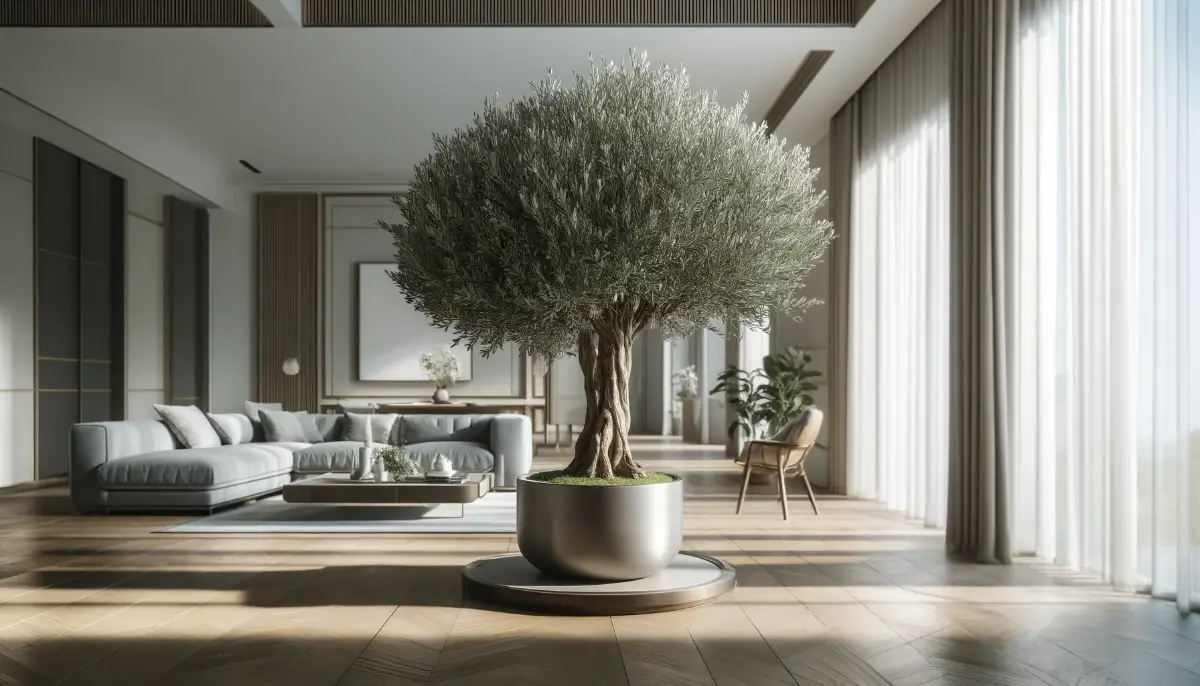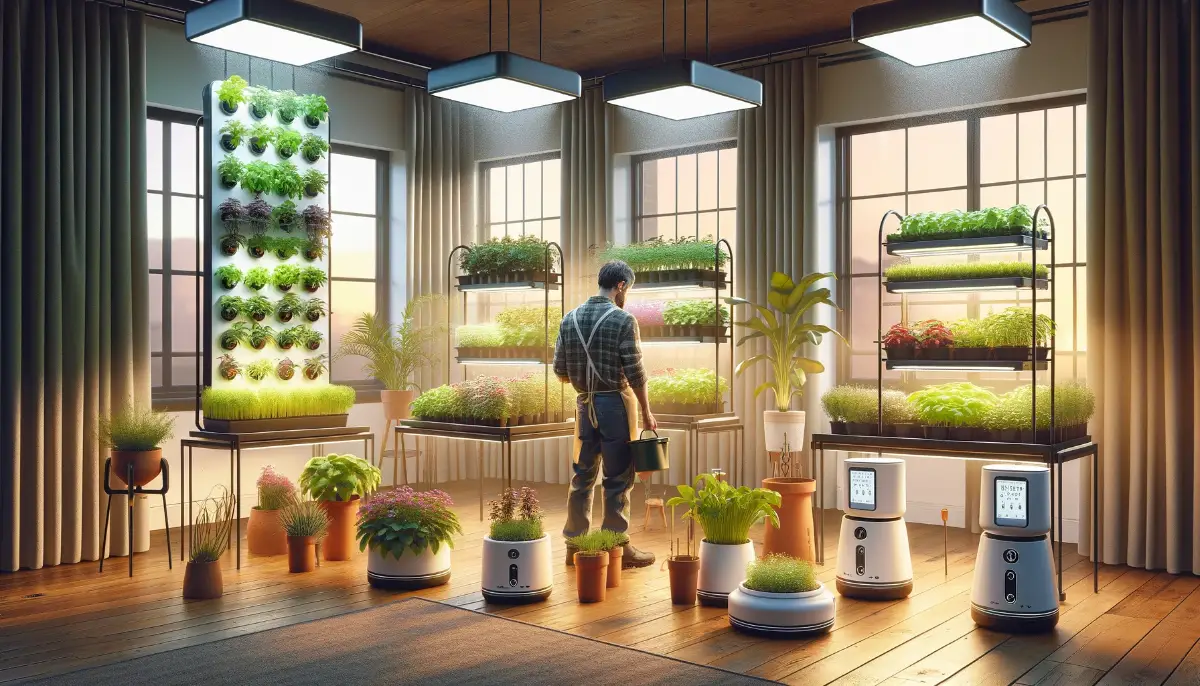Growing an indoor olive tree brings not just a touch of Mediterranean flair to your home but also offers a range of benefits both aesthetic and practical.
Renowned for their sleek, silvery leaves and robust, gnarled trunks, olive trees can transform any indoor setting into a piece of living art, adding a serene and sophisticated ambiance to your space.
But the advantages extend beyond beauty. These resilient trees are an excellent choice for indoor gardeners looking to enhance their green spaces without the constant upkeep that more delicate plants might require.
As long as they’re provided with enough light and proper care, indoor olive trees can thrive, offering the possibility of fresh olives right from the branch, though fruiting is less common indoors.
Choosing the Right Olive Tree
When deciding to grow an olive tree indoors, selecting the right variety is crucial to ensure it adapts well to indoor conditions and fits aesthetically within your space. Here’s a guide to help you make the best choice:
- Dwarf Varieties: Opt for dwarf or semi-dwarf varieties of olive trees as they are more suited for indoor environments due to their manageable size and slower growth rate. Varieties like ‘Arbequina’, ‘Koroneiki’, and ‘Picual’ are popular choices as they can thrive in pots and still produce fruit under the right conditions.
- Container Size and Growth: Select a tree that will be proportionate to the space you have available. Dwarf olive trees, for example, can be kept under 6 feet tall with regular pruning. The container should be large enough to accommodate the tree’s root system but not so large that the soil stays wet for too long, which can lead to root rot.
- Sunlight Requirements: Since olive trees require a lot of light, choose a variety that can thrive with the amount of natural light you can provide. If your indoor space does not have adequate natural light, consider using grow lights. Varieties that are particularly adaptable to less than ideal light conditions might fare better indoors.
- Fruiting Potential: While fruiting is a challenge for indoor olive trees due to lack of pollination and optimal environmental conditions, some dwarf varieties might still produce olives if care conditions are met, including sufficient light and careful watering.
- Aesthetic Considerations: Beyond practical aspects, consider the tree’s appearance. Olive trees are known for their attractive, gnarled trunks and silvery leaves, which can add a dramatic touch to indoor decor. Choose a variety that complements your home’s style.
By carefully selecting the appropriate variety and understanding the care requirements, you can enjoy the beauty and benefits of an indoor olive tree for many years.
Potting and Soil Requirements for Indoor Olive Trees
Proper potting and selecting the right soil are critical factors in the healthy growth of indoor olive trees. Here’s what you need to know to set up your tree for success:
- Choice of Container: Olive trees need pots that will accommodate their root growth without being overly large. A pot that’s too big can lead to waterlogged soil, which increases the risk of root rot. Choose a container with adequate drainage holes to allow excess water to escape. Generally, a pot 1-2 sizes larger than the current one is sufficient when repotting.
- Soil Type: Olive trees require well-draining soil to prevent water retention and subsequent root issues. A mix that includes ingredients like perlite, sand, or even a cactus mix can provide the drainage these trees crave. The soil should allow for air circulation around the roots, which is crucial for their health. If you’re unsure, commercial potting mixes designed for succulents or cacti can be a good choice due to their excellent drainage properties.
- pH Level: Olive trees prefer a soil pH between 5.5 and 8.5, which allows them to absorb nutrients effectively. Most commercially available potting mixes should fall within this range, but it’s a good idea to check the pH if your tree shows signs of nutrient deficiencies.
- Repotting Frequency: Olive trees grow relatively slowly, so frequent repotting is not necessary. Typically, young trees should be repotted every two to three years, or when they outgrow their pots. For older, more established trees, top-dressing by replacing the top layer of soil with fresh potting mix can suffice instead of full repotting. This helps refresh the nutrients without the stress of complete repotting.
By ensuring that your indoor olive tree is potted correctly with the appropriate soil, you can significantly enhance its growth and vitality, setting the stage for a healthy indoor plant that beautifies your space and possibly even bears fruit.
Light and Placement for Indoor Olive Trees
Ensuring your indoor olive tree gets the right amount of light and is placed appropriately within your home are key factors in its growth and health. Here are detailed guidelines to help you optimize these conditions:
- Adequate Sunlight: Olive trees thrive in full sun, requiring at least six to eight hours of direct sunlight daily. This is crucial for their health and vitality. When choosing a location for your olive tree, place it near a south-facing window which tends to receive the most sunlight throughout the day. If such a location isn’t available, east or west-facing windows are the next best options.
- Use of Artificial Lighting: In situations where natural sunlight is insufficient, particularly in winter months or in less sunny climates, supplemental lighting can be beneficial. Grow lights, specifically LED or fluorescent lights, can provide the necessary spectrum of light needed by olive trees. Position these lights about 12-18 inches above the tree and keep them on for 9-12 hours a day to mimic natural sunlight conditions.
- Rotation for Even Growth: To prevent your olive tree from growing lopsided, rotate the pot a quarter turn weekly. This ensures that all sides of the tree receive equal light, promoting symmetrical growth.
- Avoiding Temperature Extremes: While focusing on light, it’s also important to consider temperature. Olive trees prefer a temperature range of 60-80°F (15-27°C) and do not fare well in drafts or sudden temperature changes. Placing your tree away from heat sources in winter and air conditioning vents in summer helps maintain a stable environment conducive to growth.
By carefully managing the light exposure and placement of your indoor olive tree, you can significantly enhance its chances of thriving, potentially even leading to fruit production under optimal conditions.
Watering and Humidity for Indoor Olive Trees
Proper watering and maintaining the right humidity level are crucial for the health of indoor olive trees. Here’s how to ensure your tree receives the appropriate care in these areas:
- Watering Schedule: Indoor olive trees prefer their soil to be on the drier side, so it’s important to allow the soil to dry out between watering sessions. Typically, this means watering once the top inch or so of the soil feels dry to the touch. During the active growing season in spring and summer, watering might be needed once every 1-2 weeks, depending on the humidity and temperature of your home. In the winter, reduce the frequency of watering to reflect the tree’s slower growth rate.
- Signs of Overwatering: Overwatering is a common issue with indoor olive trees. Signs of too much water include yellowing leaves, a common symptom of root rot. If the pot feels unusually heavy or the soil smells musty, these can also be indicators that the tree is receiving more water than it needs.
- Humidity Considerations: While olive trees can tolerate a range of humidity levels, they generally prefer conditions on the drier side. However, if your indoor air is particularly dry, especially during winter when heating systems are running, providing some humidity can be beneficial. This can be achieved by placing a water tray near the heating system or using a humidifier. Alternatively, occasional misting can help, but it should not be overdone as olive trees do not require high humidity.
- Monitoring Soil Moisture: Using a moisture meter can be a helpful way to avoid over or under-watering. It gives a more accurate reading of the moisture level deep within the pot, which can be more reliable than simply feeling the soil surface with your fingers.
By carefully managing watering and humidity, you can help your indoor olive tree maintain its health and vitality, potentially extending its lifespan and enhancing its beauty as a part of your home decor.
Fertilization Schedule for Indoor Olive Trees
Adopting an organic approach to fertilizing your indoor olive tree not only supports the health of the tree but also ensures you are caring for your indoor environment and overall ecosystem sustainably. Here’s how to create an effective organic fertilization schedule:
- Type of Fertilizer: Use organic fertilizers that are typically slower releasing but safer for your tree and home environment. These can include organic granular fertilizers or liquid seaweed and fish emulsion blends. These options provide a balanced range of nutrients and are less likely to burn the plant’s roots compared to synthetic fertilizers.
- Timing and Frequency: Fertilize your olive tree primarily during its active growth periods in spring and summer. Applying organic fertilizer once a month during these seasons supports vigorous growth and healthy development. Reduce fertilization to once every two months during the fall and cease fertilizing in winter when the tree’s growth naturally slows down.
- Application Method: When applying granular organic fertilizer, sprinkle it around the base of the tree, away from the trunk, and water it in thoroughly to help distribute the nutrients into the soil. For liquid organic fertilizers, dilute as directed and apply to the soil, ensuring not to splash the leaves or stem to avoid potential burn.
- Soil Health: In addition to direct fertilization, enhancing the soil’s organic matter can improve nutrient availability and soil structure, benefiting your olive tree. Incorporate compost into the soil at the time of repotting or as a top dressing. This method not only feeds the soil slowly but also enhances microbial activity, which is beneficial for root health.
Using these organic methods for fertilizing your indoor olive tree ensures a natural and environmentally friendly approach to plant care, promoting sustained growth and reducing chemical use within your home.
Pruning Techniques
Proper pruning is essential for maintaining the health, aesthetics, and productivity of indoor olive trees. Here are some techniques to help you effectively prune your indoor olive tree:
- When to Prune: The best time to prune your olive tree is in the late winter or early spring, just before the new growth begins. This timing allows the tree to heal quickly without risking exposure to extreme cold or heat immediately after pruning.
- Pruning Objectives: The primary goals of pruning are to shape the tree, encourage healthy growth, remove dead or diseased wood, and improve light penetration and air circulation throughout the tree. For indoor olive trees, pruning also helps manage the tree’s size, making it suitable for indoor conditions.
- Technique Basics: Start by removing any dead, diseased, or damaged branches. Cut these branches back to healthy wood, ideally at a 45-degree angle to promote water runoff and prevent disease. Next, thin out any branches that are crossing or rubbing against each other to reduce the risk of damage and disease.
- Shaping and Thinning: To maintain a pleasing shape and ensure adequate light and air reach all parts of the tree, selectively prune back overly vigorous branches, especially those growing inward toward the center of the tree. This helps maintain an open, airy structure. Be careful not to remove more than one-third of the tree’s total foliage in a single pruning session, as this can stress the tree.
- Tools to Use: Use sharp, clean pruning shears or a pruning saw for larger branches. Clean your tools before and after pruning to prevent the spread of disease. Make clean cuts close to a bud, node, or branching point to encourage healthy new growth.
Following these pruning guidelines can help keep your indoor olive tree healthy, well-shaped, and more likely to thrive in an indoor environment. Regular pruning not only improves the appearance of your tree but also its overall health and vitality.
Pollination and Increasing Fruit Yield
Achieving fruit production from indoor olive trees can be challenging due to the limited natural pollinators and less-than-ideal environmental conditions. However, with the right techniques, you can increase the chances of your olive tree bearing fruit. Here’s how to handle pollination and encourage fruit yield:
- Understanding Pollination Needs: Olive trees are typically wind-pollinated, which means they rely on the movement of air to transfer pollen from the male parts of the flower to the female parts. In an indoor setting, this natural wind is absent, so you’ll need to assist in the pollination process.
- Manual Pollination Technique: You can simulate wind pollination by gently shaking your tree to help distribute the pollen. Alternatively, use a small paintbrush or cotton swab to transfer pollen from flower to flower. This method mimics the action of pollinators like bees and can be quite effective in ensuring that the flowers are pollinated.
- Environmental Factors: To support flowering and fruiting, ensure your olive tree is exposed to enough light and the right temperature fluctuations. Olive trees require a period of cooler temperatures during the winter to stimulate flowering in the spring. Try to mimic these natural conditions as much as possible within your home setting.
- Fertilization for Fruit Production: Applying a balanced, low-nitrogen, higher-potassium fertilizer can promote flowering and fruiting. Potassium helps in the development of fruits, so a fertilizer with a higher K-value is preferred during the flowering and fruiting phases.
- Regular Care: Consistent care in terms of watering, light exposure, and temperature control also plays a crucial role in the overall health of your tree, which indirectly influences its ability to produce fruit.
By carefully managing these aspects, you can maximize your indoor olive tree’s potential to flower and perhaps even produce fruit, bringing a delightful element of the Mediterranean right into your home.
Pests and Diseases in Indoor Olive Trees
Indoor olive trees can encounter various pests and diseases that may hinder their growth and health. Here are some common issues and strategies for dealing with them effectively:
- Pests Commonly Found on Indoor Olive Trees:
Scale Insects: These pests appear as small, brown, dome-shaped spots on the stems and leaves of the tree. They suck sap from the tree, weakening it over time. To manage scale, use a cotton swab dipped in rubbing alcohol to remove them manually or apply an organic insecticidal soap.
Spider Mites: Indicated by fine webs on the tree and tiny red or brown dots moving on the leaves. Spider mites thrive in dry conditions, so increasing humidity around your tree can help prevent them. If infestation occurs, rinsing the tree with water or using neem oil can be effective.
Mealybugs: These look like small cottony patches on the leaves and stems. They can be removed by wiping with alcohol or treating with neem oil, which acts as a natural pesticide.
- Diseases to Watch For:
Root Rot: This is often caused by overwatering and poor drainage. Symptoms include soft, brown roots and wilted leaves. Prevent root rot by ensuring your pot has good drainage and by letting the soil dry out between waterings.
Leaf Spot: Caused by fungal or bacterial infections, characterized by dark spots on leaves. Improve air circulation around the tree and reduce leaf wetness to manage this problem. Fungicidal sprays may also be necessary in severe cases.
Olive Peacock Spot: A fungal disease that creates circular, dark spots on leaves, leading to defoliation. It’s important to clean up fallen leaves and possibly apply copper-based fungicides in the fall to prevent spring outbreaks.
General Maintenance Tips:
- Regularly inspect your olive tree for signs of pests and diseases.
- Keep the area around your tree clean and free of plant debris to minimize the risk of disease.
- Ensure your tree receives adequate ventilation and light, as these conditions help promote a healthy tree less susceptible to issues.
By staying vigilant and responding promptly to the signs of pests and diseases, you can keep your indoor olive tree healthy and thriving. Regular preventive measures and appropriate responses to problems as they arise are key to successful indoor olive tree care.
FAQs About Indoor Olive Tree Care
How much light does an indoor olive tree need?
Indoor olive trees require at least six to eight hours of direct sunlight per day. If natural sunlight is inadequate, supplementing with grow lights is recommended.
How often should I water my indoor olive tree?
Water when the top inch of soil feels dry. Typically, this might be once every 1-2 weeks, depending on the humidity and temperature of your indoor environment.
What is the best soil for an indoor olive tree?
A well-draining potting mix is ideal. Mixes designed for cacti or succulents, which include sand or perlite, can work well for olive trees.
When is the best time to prune an indoor olive tree?
Prune in late winter or early spring, just before new growth starts, to shape the tree and remove any dead or unhealthy branches.
Can indoor olive trees actually produce fruit?
Yes, but fruiting is less common indoors due to lack of pollination and optimal environmental conditions. Manual pollination can help increase the chances of fruiting.
What are common pests that affect indoor olive trees?
Common pests include scale insects, spider mites, and mealybugs. These can be managed with insecticidal soaps or natural oils like neem oil.
How do I repot an indoor olive tree?
Repot every two to three years or when the tree outgrows its pot. Choose a slightly larger pot and fresh well-draining soil to encourage healthy growth.
What are signs of overwatering in an indoor olive tree?
Signs include yellowing leaves, a heavy and waterlogged pot, and a musty smell from the soil, indicating potential root rot.
How can I increase humidity for my indoor olive tree?
While olive trees don’t require high humidity, if your indoor air is very dry, use a humidity tray or occasional misting to increase moisture around the plant.
What type of fertilizer should I use for an indoor olive tree?
Use a balanced, organic fertilizer with a focus on potassium during the growing season. Fertilize monthly in spring and summer and reduce in winter.










